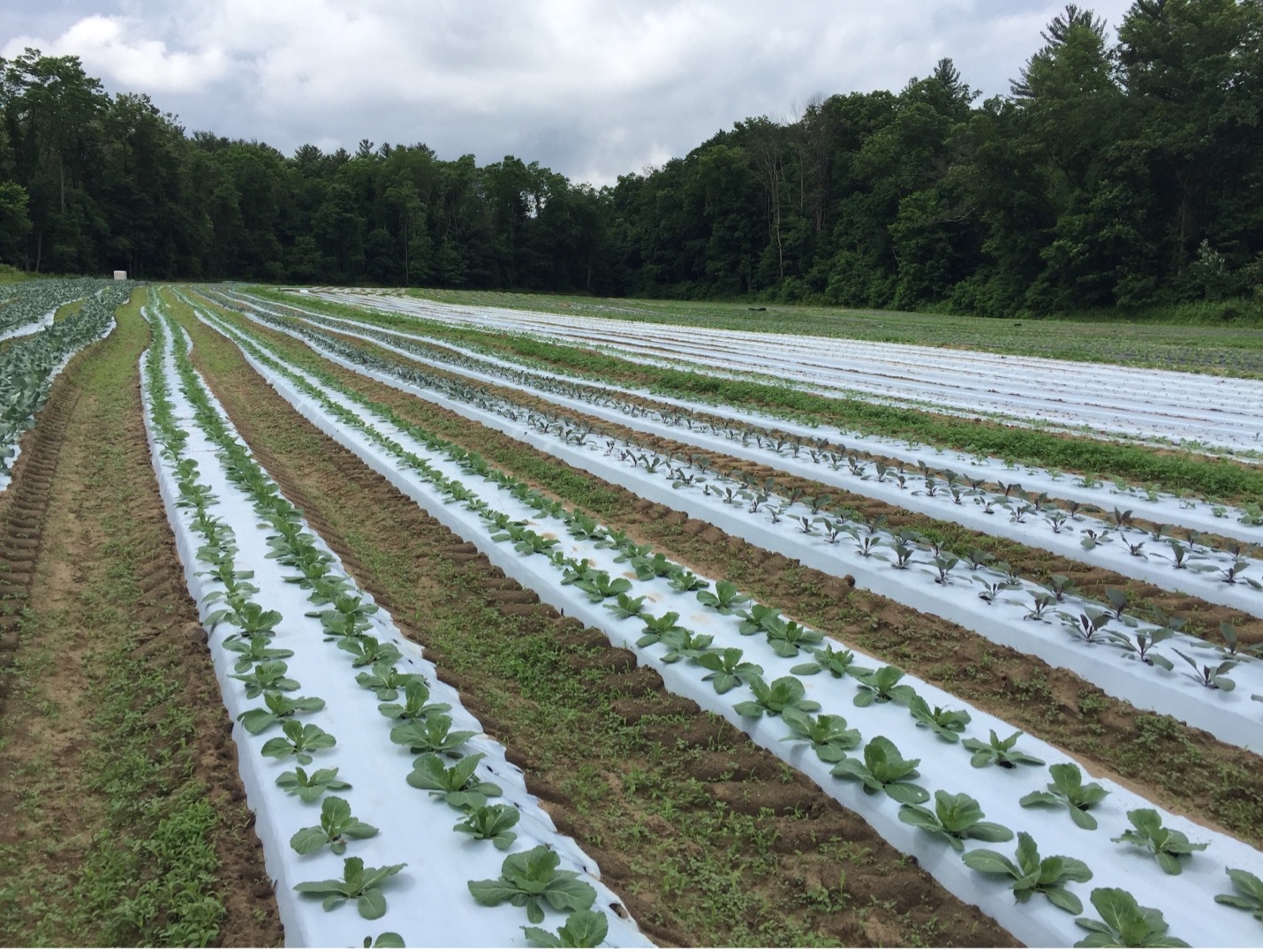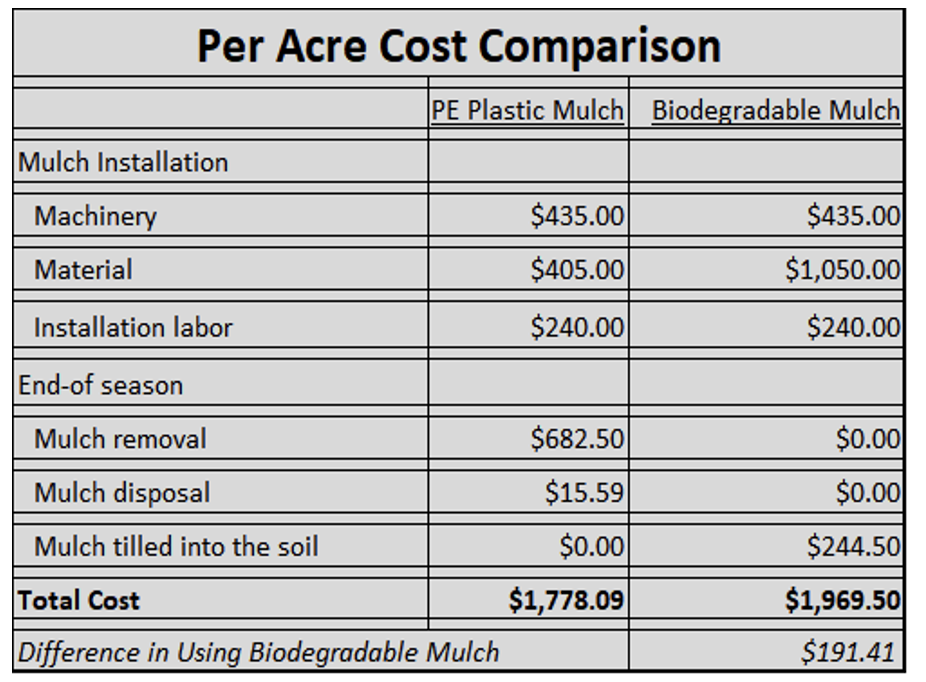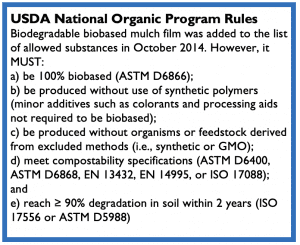By Shuresh Ghimire, UConn Cooperative Extension and Andy Radin, URI Cooperative Extension
Something important for you to consider: your use of plastic mulch in vegetable production. This is especially worthy to think about given that plastic mulch isn’t just for tomatoes, peppers, and eggplant anymore. Most small-scale growers use it for onions, lettuce, herbs, and more. You’ve no doubt heard about biodegradable mulch, but possibly not so great things. Here are some important questions you may have, and some real answers.
- Can plastic mulch actually “degrade?” Yes, and No.
First, the NO.
Degradation caused by sunlight, heat, moisture, and mechanical stress results in ever-smaller fragments of plastic, ultimately becoming what are called “microplastics.” According to a quick search on Google Trends, this word as a topic has increased dramatically over the last 5 years, which corresponds to an increase in our understanding of just how pervasive these pollutants are on land and in the oceans, and the possible and probable effects they have on species richness and diversity. It’s a disturbing and inescapable fact that plastics are changing the planet for the worse.
Now for the YES!
Degradation of plastic by microorganisms, known as biodegradation, is very much a real thing, provided the plastic is made of the polymers that microbes can consume. Soil-biodegradable plastic mulch breaks down into CO2, water, and microbial biomass.
But let it be stated right here up front: except for paper-based mulches, there are no biodegradable plastic mulches that are approved for use by certified organic farms in the United States. (See Box with NOP standards for reasons why.) If you are a certified organic grower, you cannot make the switch. You are permitted to use paper-based mulches, as long as they do not contain any synthetic materials. However, as they reduce the soil temperature, these do not perform well in our cold springs and early summers when warmth is desired. Further, our (usually) plentiful rainfall and warm summer weather causes rapid breakdown of these materials.
But if you otherwise do use plastic mulch, please read on as we consider a list of potential issues with the use of soil-biodegradable mulch (BDM.)
- How much do BDMs break down during the growing season?
Ghimire et al. (2018) found that among 4 products they tested for pumpkin production for two years in Mount Vernon, WA and Knoxville, TN, by the end of the season, less than 8% of the soil originally covered became exposed in Mount Vernon, and that was less than 25% in Knoxville. At Mount Vernon, the 2-year average daily air temperature for the pumpkin growing season (June–September) was 63 °F, RH was 76%, and total rainfall was 6 inches (4 inches in year 1 and 8 inches in year 2). At Knoxville, the 2-year average daily air temperature was 77 °F, RH was 80%, and total rainfall was 10 inches (14 inches in year 1 and 5 inches in year 2). These mulches really hold up during the season they are applied!

Our team also looked at that over several years and found relatively similar yield results between BDM and PE mulch. Unfortunately, it’s difficult to state this definitively because in a survey of comparative studies, Martín-Closas et al. (2017) found better performance, worse performance, and equal performance between BDM and PE. But these were in a wide range of soil and climate conditions. The chances of BDM performing better than PE in an exceptionally wet summer in eastern North Carolina are slim- the stuff will break down more rapidly, so you do take something of chance there.
- Will last year’s mulch bits disappear by the time I am prepping beds this coming year?
Visual assessments of macroscopic BDM fragments (>2.36 mm) show that after 4 years of annual BDM application from 2015 to 2018 in northwest Washington, mulch recovery from soil in spring 2019 ranged from 23 to 64% of the amount applied (area basis), indicating there was no accumulation of mulch fragments in the soil even after repeated applications (Ghimire et al., 2020). Recovery further decreased to 4-16% (mass basis) 2 years after the final mulch incorporation in fall 2020 (Griffin-LaHue et al., 2022). Only paper BDMs (e.g. Weed Guard Plus) show 100% biodegradation within the timespan of this study, but the conclusion from the study was that BDMs are degrading and do not accumulate in soil after repeated use. The longevity is strongly influenced by soil texture [see footnote], climatic factors (annual rainfall, annual average air temperatures), and product formulations. As you might expect, biodegradation is more rapid in warmer, wetter climates and in medium textured soils which have the benefits of good water-holding capacity as well as decent porosity.
Yes, there is differential breakdown among the products, and some of it remains for up to a few years. Products that perform the best within a season also probably leaves residues for longer. These are often thicker. But that doesn’t mean it leaves behind microplastics. The limits of instrumentation make it nearly impossible to document the final-most end-stage of decomposition of soil biodegradable plastic, whereas microplastics are actually detectable.
- Isn’t BDM more expensive than PE mulch?
Yes, it really is more expensive to purchase the material- two to three times more, depending on thickness. Plan to lay out more cash on the front end of the season. BUT: don’t forget to calculate how much you can save on the back end. There’s an easy to use calculator available for download here. [Note: this link will take you to an Excel spreadsheet on your browser tab. You can download it by clicking on the “File” menu in the upper left-hand corner of the spread sheet and then click on “download.” After doing that, make sure that you enable the macro features.]
Below is what the calculator generated based on using 3- three-thousand-foot rolls of mulch on an acre. There are many assumptions built into this output, and the spreadsheet allows you to adjust all of those. But going with what they filled in for default estimates (labor rates, tractor time, dumping fees, and more), take a look.
In this case with all of the default values they started with (again, which you can adjust), it costs 11% more per acre. In case you’re wondering, many of the dollar values they used are on the generous side, so this may be an over-estimate. Over-estimating is always good in enterprise planning, at least to a point.
Other factors not accounted for in the spreadsheet:
- Aggravation/Procrastination factor: there’s nothing like an un-fun job to persuade you to do other things that seem less aggravating. But pulling out the drip tape is the only thing stopping you from disking over your plastic-mulched beds.
- Interference with timeliness of cover crop planting: getting those beds cleaned up speeds you towards getting your cover crop seed planted. Getting deep into the financial analysis, it’s entirely possible that the earlier cover crop planting recovers more nutrients and increases organic matter in your soil, which are things you can take to the bank.
- If you grow into the fall and winter, you have tunnels to clean up but also fall planting deadlines to keep. Deadlines like that can easily cause a delay of field cleanup because every day of waning daylight in mid to late September reduces fall tunnel crop growth.
- You are putting less polyethylene mulch onto the land and eventually, into the ocean. Hard to calculate costs associated with that, but they are real.
- Can it be applied in the field just like PE mulch?
Yes, more or less BUT three caveats:
- It is more delicate than PE so it has to be handled a little more gently.
- If it does get damaged while laying it down, decomposition will be accelerated
- MOST IMPORTANT- it should not be applied as tightly as PE mulch because it continues to tighten as the weather warms. If it is installed too tightly at first, it will split as it tightens up, and this will allow early summer weeds to take over.
- What are the common experiences of the growers using BDM in Connecticut?
- PE mulch leaves more fragments in the field than BDM
- The purchasing cost of BDM is greater than PE, so BDM appears to be expensive in the beginning of the growing season, but overall BDM is cheaper after accounting for disposal costs
- Growers can prepare the field for cover crops at the end of the season when the crop is grown with BDM; the mulch is disked/harrowed in after the drip tape is removed, which does not require much extra field work. But in years with wet Fall, cover crops are delayed or cannot be planted when PE mulch is used
- Even with mulch deterioration in the later season, no/minimal weed growth occurs
- Some growers shared experience of mulch adhesion with cantaloupe, but has not affected marketability of crops
- Removal of PE mulch and picking up fragments at the end of the season is the least liked job of growers
- Weed control and yield is comparable between BDM and PE mulch
- They do not have any concern with BDM fragments after incorporation in the field as their observation is that BDM degrades in a couple of years

Think it over- it could change things for your late summer-into-fall transition… for the better. For a video testimonial from a Connecticut farmer, watch this video.
You still have questions about BDM, this FAQ FAQs about BDM might help.
Footnote: We did not specifically look at the relationship between soil texture and mulch biodegradation rate. However, a study from Brazil (Duarte et al. 2019) reports that the CO2 production was much higher when a biodegradable mulch was tested in sandy-loam textured soil compared to clay and sand-textured soil. In general, degradation rate would be higher in the soil where there are greater populations of microbial communities, the soil is not too dry or not too wet (balance of water and air in the soil pore/capillaries). This probably means greater degradation rate in sandy loam or silty loam soil than clay or sands.
Useful links
- A video testimonial from a Connecticut farmer https://www.youtube.com/watch?v=kyvB1QxHAtE
- Biodegradable mulch for pumpkin production: https://journals.ashs.org/hortsci/view/journals/hortsci/53/3/article-p288.xml
- FAQs about BDM: https://s3.wp.wsu.edu/uploads/sites/2181/2021/01/FAQs-about-BDM.pdf
- In-field degradation of soil-biodegradable plastic mulch film: https://doi.org/10.1016/j.scitotenv.2021.150238
- Mulch calculator: https://ag.tennessee.edu/biodegradablemulch/
- Mulch films biodegradation rate in different types of soil: https://www.actahort.org/members/showpdf?booknrarnr=1242_2
- Sampling and degradation of biodegradable plastic and paper mulches in field after tillage incorporation: https://doi.org/10.1016/j.scitotenv.2019.135577
